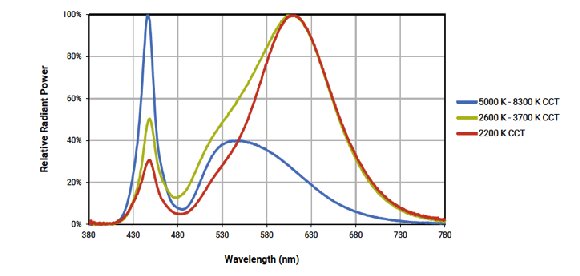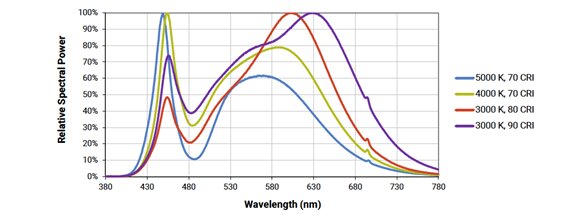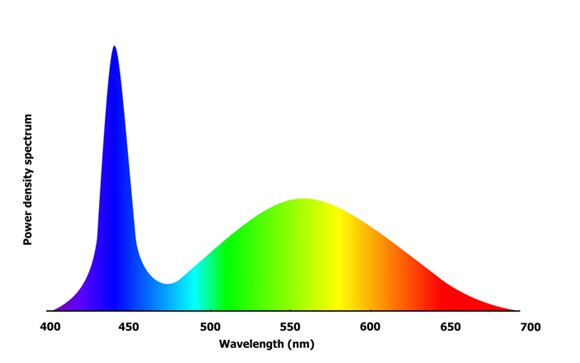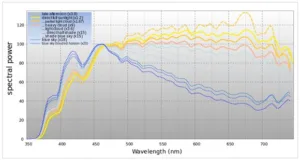You might have heard many times from many people that reading a book is the best way to fall asleep. I am not a consistent book reader and I fall asleep quite easily with or without reading. Recently, I read an article about the physiological effect of light on people, in particular, the effects on the human body, in more particular, the circadian lighting.

For various reasons and developed through evolution, human beings have a 24-hour period body clock caused mainly by the cyclical light and dark environment produced by natural sunlight during the day and without sunlight at night, from the beginning of time. Light with wavelengths lower than 500 nm affects the circadian rhythm of human beings more so than longer wavelength light.
The photoreceptors in the eyes, around the periphery, have high sensitivity from 460 nm to 490 nm, with a peak at 480 nm.These photoreceptors send signals to the brain, creating biological effects that suppress the level of melatonin, which is a hormone that changes the synchronization with the circadian rhythm. The level is highest during the circadian night and is lowest during the circadian day. I started to think that by decreasing the level of light level in the 460 nm to 490 nm ranges, the level of melatonin could be increased, thus putting the person into the circadian night, i.e. putting the person to sleep.
How do these effects relate to displays? We are living in a world full of displays from cell phones, televisions, movie theaters, etc. We are constantly bombarded with light, either directly from light bulbs, light emitting displays, or the various back lights through the LCD panels. These light sources are by no mean “perfect”. When I say perfect, I mean they are not the sames as direct natural sunlight, which is considered to be as perfect as it can be. This is why high-pressure xenon lamps are used in movie theaters as they are very close to “perfect”.
The perfect light, the real sunlight at noon without clouds, has a color temperature of 6,000K and color rendering index (CRI) of 100. Most of the “old” light sources, namely, incandescent lamps, operates by heating up tungsten filaments to various temperatures, have CRI of 100, but with color temperature much lower than 6,000K. Most common 40 W bulbs have a color temperature of about 2,700K, which we are used to seeing, and we consider them “warm”. Most LED light bulbs have a color temperature around 5,000 K to 6,000 K, and considered to be “cool” and the outputs appear to be bluish.
Spectra of Sunlight under Various Conditions
As lighting technologies have advanced, many other types of light bulbs have become available, such as fluorescent light, metal halide lamps, etc. These light sources are mainly developed for higher efficiency operations, i.e. more visible light output per electrical watt. However, many of these lamp outputs are not perfect, and do not have continuous or smooth spectra similar to the sun and as a result, they do not produce the same visual effect as direct sunlight.
The colors of illuminated objects can appear different under these lighting conditions when compared to direct sunlight. In order to characterize these lamps in the same simple terms as color temperature and CRI, special correlations, equations and formulae are needed. The end result was the introduction of the correlated color temperature (CCT) in which light sources can be different, but with the same CCT. Similarly, light sources can have the same CRI, but be quite different.
Without going into statistics, I believe that the most widely used displays are in cell phones by teenagers. We are all concerned about their health. There have been many studies in the last ten years showing that excessive cell phone use affects sleep in teens. I am sure that excess cell phone use for non-teens like us, while less common, can lead to sleep problems also. One reason for such undesirable effect is that the light sources for the display are usually white LED driven.
These LED sources have a spectrum that dips in the region around 460 nm to 490 nm. Depending on the CCT and the CRI, the amount of light in this region varies. It should be noted that higher CRI light sources have more uniform spectral output, with a good chance of increasing light output in the 460 nm to 490 nm. On the other hand, it is well known that the improvements of CRI are at the expense of efficiency. Roughly, each unit increase in CRI reduces the efficiency of the light source by about 1 %.
For example, roughly, a LED with an efficiency of 100 lumens per watt with CRI of 70 could roughly have an efficiency of 70 lumens per watt if the CRI is increased to 100. In addition, the lower color temperatures and the use of warmer light bulbs also lowers the efficiency. The cost of LEDs with higher CRI and lower color temperatures is also higher as various recipes of phosphors are used with multiple LEDs with various wavelengths being combined together in the same lamp fixture.
Cost is the main reason that higher efficiency LEDs with lower CRI are selected during the design cycle if low color temperature and high CRI are not needed. The same logic is the reason that fluorescent lamps were used in the old days and are still being used now. Their lighting effects are not as good as incandescent, but they operate at much higher efficiency.


The introduction of OLED and Quantum Dot LCDs added more variety and choices for the designers. On the other hand, I do not believe that physiological effects have been the main concerns in the design choices, yet, but rather the visual effects of the final display product have been the priority. For backlit LCD panels, the output of the light sources are also modified by the color filters. Filters take light out rather than putting light in. As a result of the use of filters, the amount of light in the 460 nm to 490 nm is further reduced.


Apple acknowleged some of these concerns of excess blue light in their smartphone displays. In March 2016, a new feature called Night Shift was introduced in the iOS 9.3 update. Not much information was available, but the main function was to help users get to sleep better at night, after using the mobile iOS device such as an iPhone or an iPad. There have been many studies that have shown that exposure to bright blue light in the evening, mainly centered at 445 nm, can affect the circadian rhythms and make it harder to fall asleep. Apple’s Night Shift uses your iOS device’s clock and geo-location to determine when it’s sunset in the user’s location and it automatically shifts the colors of the display to the warmer end of the spectrum and returns to its standard setting in the morning.
Lasers Add Complexity
The introduction of lasers into light sources adds further flexibility and at the same time, complexity to the lighting and display world. Lasers can be used directly, “as-is”, with their intrinsic narrow line widths with red, green, blue colors, or using the blue lasers as the excitation light source for phosphors generating “white” light, similar to white LEDs, and will not be discussed further here.
 Laser phosphor spectrum
Laser phosphor spectrum
For the “as-is” or direct laser light sources, the “full spectral gamut” displays are usually driven by red, green, and blue (RGB) lasers with wavelengths around 446 nm, 532 nm, and 628 nm. Since these laser outputs have narrow line widths and there is absolutely NO light in the region between 460 nm to 490 nm. It really means that there is “ZERO” suppression of melatonin putting the viewers into the circadian night, or, simply, putting the viewers to sleep. As direct laser projection displays are on the rise, both in movie theaters and small home projectors, it will be interesting to see whether such projectors actually put viewers to sleep more often than other projection sources. Of course, most laser projection environments are very dark to begin with.
Back to Books
Let’s get back to book reading. Do you still need to read a book falling asleep? The answers are more complicated these days. What books? Paper or Electronic? For paper, what light bulbs (color temperature, CRI, etc)? For electronic, what light sources (LED backlight, OLED, etc.)? As a result, not every “book” would put you to sleep. May be you would have to pick a “book” that is very boring and force yourself to read it and fall asleep quickly. If you find such a book, most likely electronic these days, it could last a lifetime. On the other hand, it might be wise for you to read a boring book electronically, having a display with a bluish backlight, so that you would not fall asleep and finish it before sunrise.
Any comments or inputs can be directed to the author at [email protected]

